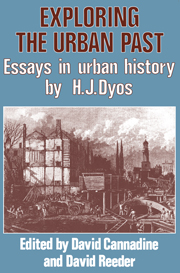Book contents
- Frontmatter
- Contents
- Acknowledgements
- Introduction: H. J. Dyos and the urban process, by David Reeder
- Part One The Urbanising World
- Part Two Transport and Urban Transformation
- Part Three The Urban Fabric
- 9 The slums of Victorian London
- 10 The speculative builders and developers of Victorian London
- 11 A Victorian speculative builder: Edward Yates
- 12 A guide to the streets of Victorian London
- Conclusion Urban history in the United Kingdom: the ‘Dyos phenomenon’ and after, by David Cannadine
- Appendix: A bibliography of the published writings of H. J. Dyos
- Notes
11 - A Victorian speculative builder: Edward Yates
Published online by Cambridge University Press: 03 February 2010
- Frontmatter
- Contents
- Acknowledgements
- Introduction: H. J. Dyos and the urban process, by David Reeder
- Part One The Urbanising World
- Part Two Transport and Urban Transformation
- Part Three The Urban Fabric
- 9 The slums of Victorian London
- 10 The speculative builders and developers of Victorian London
- 11 A Victorian speculative builder: Edward Yates
- 12 A guide to the streets of Victorian London
- Conclusion Urban history in the United Kingdom: the ‘Dyos phenomenon’ and after, by David Cannadine
- Appendix: A bibliography of the published writings of H. J. Dyos
- Notes
Summary
In Victorian England, the speculative builder was widely regarded as a kind of deadly spider, spinning houses in his cobweb to catch unsuspecting victims in, a jerry-builder, a scamping builder who mixed dust with his mortar, or who cut the footings, or quickly railed over the green timber, or got up to a thousand tricks to avoid building good and true. Despite the persistent lack of any substantial body of hard evidence on the matter, the legend took root, the familiar gibes were thrown, and the mud that stuck on the few also spattered many, especially at the lower end of the market, where operating margins were so slight that a few weeks of hot sun or of hard rain could wipe out any prospect of getting rid of a new house that had been scamped in some hidden way.
But the operations of Edward Yates, and the enduring condition of every one of his suburban houses that have descended into the third and, indeed, the fourth generation of him that built them, offer undeniably hard evidence that points to a different judgment on the speculative builders of the suburbs of Victorian London. In the course of this essay, I should like to set out his career as a builder and developer and, to some degree, as a landlord and man of property, in as much detail as his surviving business records permit us to do.
- Type
- Chapter
- Information
- Exploring the Urban PastEssays in Urban History by H. J. Dyos, pp. 179 - 189Publisher: Cambridge University PressPrint publication year: 1982

